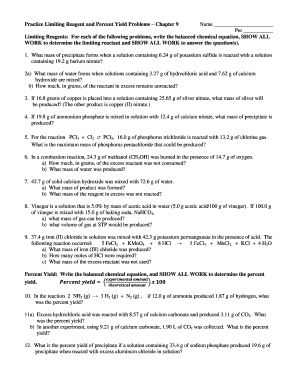Loading

Get Limiting Reagent And Percent Yield Practice Problems
How it works
-
Open form follow the instructions
-
Easily sign the form with your finger
-
Send filled & signed form or save
How to fill out the Limiting Reagent and Percent Yield Practice Problems online
This guide provides clear and supportive instructions on how to effectively fill out the Limiting Reagent and Percent Yield Practice Problems document online. Each step is designed to ensure you have a comprehensive understanding of how to approach the problems presented.
Follow the steps to complete your practice problems with ease.
- Click the ‘Get Form’ button to acquire the document and access it in your preferred editor.
- Begin by entering your name and class period in the designated fields at the top of the document. This will personalize your practice problems.
- For each problem, start by writing the balanced chemical equation as required. Be sure to accurately reflect the reactants and products involved.
- Next, carefully analyze the quantities provided for each reactant in the problem. Use these quantities to identify the limiting reagent by calculating the moles of each reactant.
- After determining the limiting reagent, apply stoichiometric principles to calculate the mass of products formed. Show all work to illustrate your calculations clearly.
- For percent yield problems, write down the equation and use your calculated theoretical yield along with the actual yield to determine the percent yield.
- Review your work for accuracy and completeness before proceeding to save your changes. You can download, print, or share your results as needed.
Ready to enhance your chemistry skills? Complete your Limiting Reagent and Percent Yield Practice Problems online today!
The number of moles of reactant is used to calculate the number of moles of another product or reactant. The reactant that produces the least amount of product is considered the limiting reactant. ... A percent yield of 100% means that, based on the reactants used, the maximum possible amount of product was produced.
Industry-leading security and compliance
US Legal Forms protects your data by complying with industry-specific security standards.
-
In businnes since 199725+ years providing professional legal documents.
-
Accredited businessGuarantees that a business meets BBB accreditation standards in the US and Canada.
-
Secured by BraintreeValidated Level 1 PCI DSS compliant payment gateway that accepts most major credit and debit card brands from across the globe.


